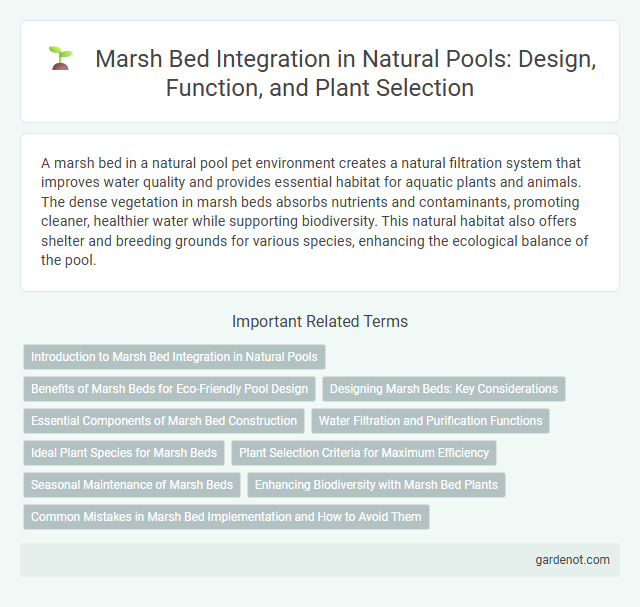A marsh bed in a natural pool pet environment creates a natural filtration system that improves water quality and provides essential habitat for aquatic plants and animals. The dense vegetation in marsh beds absorbs nutrients and contaminants, promoting cleaner, healthier water while supporting biodiversity. This natural habitat also offers shelter and breeding grounds for various species, enhancing the ecological balance of the pool.
Introduction to Marsh Bed Integration in Natural Pools
Marsh beds play a crucial role in natural pool systems by enhancing water filtration through dense vegetation and root structures that trap sediments and absorb nutrients. These biological filters help maintain clear, chemical-free water by promoting beneficial microbial activity and supporting diverse aquatic ecosystems. Incorporating marsh beds in natural pools optimizes water purification while creating habitat for wildlife, contributing to both environmental sustainability and aesthetic appeal.
Benefits of Marsh Beds for Eco-Friendly Pool Design
Marsh beds enhance eco-friendly pool design by naturally filtering water through dense vegetation, reducing reliance on chemical treatments. These biofilters support biodiversity, providing habitat for beneficial microorganisms and aquatic life that improve water clarity and quality. Incorporating marsh beds lowers energy consumption and promotes sustainable, chemical-free pool maintenance.
Designing Marsh Beds: Key Considerations
Designing marsh beds requires careful selection of native aquatic plants that enhance filtration and create habitat diversity. Optimal depth and slope ensure effective water flow and sediment settling, promoting healthy microbial activity. Incorporating layers of gravel and sand supports root stability and nutrient absorption for sustained pool clarity and ecosystem balance.
Essential Components of Marsh Bed Construction
Marsh bed construction for natural pools requires a carefully layered substrate combining sand, gravel, and organic matter to facilitate water filtration and plant root growth. Native aquatic plants such as cattails, bulrushes, and reeds are essential to stabilize the bed while enhancing nutrient absorption and habitat creation. Proper design ensures efficient biological filtration, maintaining water clarity and supporting a balanced ecosystem.
Water Filtration and Purification Functions
Marsh beds in natural pools utilize dense aquatic plants and porous substrates to enhance water filtration and purification by trapping sediments and absorbing nutrients. Microbial activity within the marsh bed breaks down organic pollutants, significantly improving water clarity and quality. This biological filtration process reduces harmful contaminants without the need for chemical treatments, supporting a sustainable and eco-friendly ecosystem.
Ideal Plant Species for Marsh Beds
Ideal plant species for marsh beds in natural pools include cattails (Typha latifolia), which excel at nutrient uptake and provide essential habitat for wildlife. Bulrushes (Schoenoplectus spp.) stabilize sediment and improve water filtration, enhancing water clarity. Pickerelweed (Pontederia cordata) contributes vibrant foliage and flowers while supporting aquatic biodiversity through oxygenation and habitat structure.
Plant Selection Criteria for Maximum Efficiency
Marsh bed plant selection for natural pool filtration prioritizes species with high nutrient uptake, deep root systems, and tolerance to water fluctuations. Commonly used plants include cattails (Typha spp.), bulrushes (Schoenoplectus spp.), and water lilies (Nymphaea spp.), which enhance water purification by absorbing excess nitrogen and phosphorus. Selecting native, resilient plants ensures sustainable ecosystem balance and maximizes the marsh bed's efficiency in filtering contaminants.
Seasonal Maintenance of Marsh Beds
Seasonal maintenance of marsh beds in natural pools involves removing accumulated organic debris to prevent nutrient buildup that can lead to algae growth. Regular pruning of marsh plants stimulates healthy growth and maintains optimal water filtration and oxygenation. Ensuring proper water levels during seasonal transitions supports the marsh bed's ability to act as a natural biofilter for the pool ecosystem.
Enhancing Biodiversity with Marsh Bed Plants
Marsh bed plants in natural pools play a crucial role in enhancing biodiversity by providing habitat and food sources for various aquatic and terrestrial species. These plants improve water quality through natural filtration, promoting a balanced ecosystem that supports fish, amphibians, and invertebrates. Integrating diverse marsh bed species fosters a resilient environment, increasing species richness and ecological stability in natural pools.
Common Mistakes in Marsh Bed Implementation and How to Avoid Them
Common mistakes in marsh bed implementation include improper plant selection, inadequate substrate layering, and poor water flow design, which can lead to reduced filtration efficiency and plant die-off. Ensuring the use of native aquatic plants suited for the local climate, layering substrates to support root growth, and designing consistent water circulation helps maintain optimal marsh bed performance. Regular monitoring and adjustments based on water quality parameters prevent common failures and promote sustainable natural pool ecosystems.
Marsh bed Infographic

 gardenot.com
gardenot.com